#interior of the pantheon rome
Text
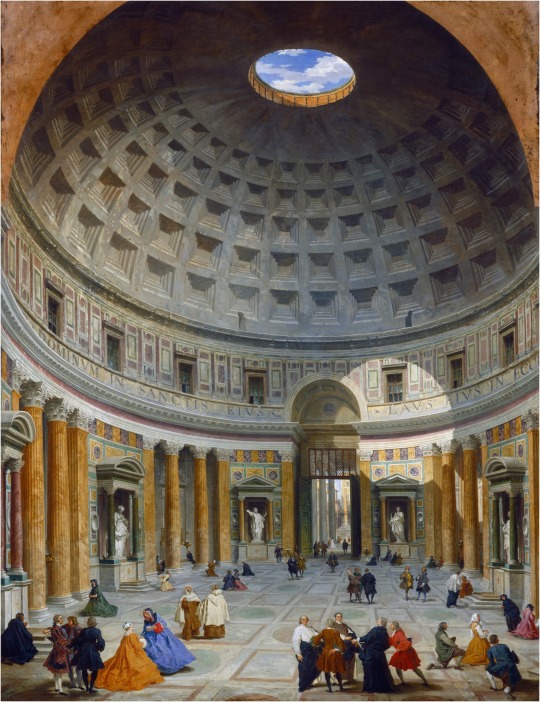
interior of the pantheon, rome by giovanni paulo panini
c. 1734; oil on canvas
#giovanni paolo panini#interior#interiors#interior of the pantheon rome#pantheon#rome#art#painting#beauty#history#classical art#love#18th century#18th century art#aesthetic#oil painting#oil on canvas#beautiful#oil paint#social#gathering#sky light
192 notes
·
View notes
Text

خلال القرن الثامن عشر، وكما هو الحال الآن، كان البانثيون أحد أكبر مناطق الجذب السياحي في روما. بُنيَ خلال حُكم هادريان في القرن الثاني للميلاد، نجا هذا المعبد الضخم من كل ضرر، وكان ذلك بسبب تحويله عام ٦٠٩ لكنيسة مسيحية (كنيسة القديسة ماريا روتوندا). نرى أن لوحة جيوفاني مأهولة بزوار أجانب والعديد من الرومان من مختلف الطبقات ممن يتجمعون في البانثيون للصلاة والدردشة والتغني بجمال المعمار. فقط تمعنوا في التفاصيل الرائعة! كان بانيني لروما مثل انطونيو كانال للبندقية. كِلا الرساما وثقا بدقة ومهارة الحياة في مدينتهما وحركة السكان.
تدريبه في المعمار والتصميم المسرحي أكسبه المهارات المناسبة ليستطيع رسم التصميم الداخلي من منظور يُظهر الجزء الأكبر منه، الأمر الصعب في حقيقة الأمر. المنظور الذي رسم منه في داخل المبنى ويقابل المدخل. تُفتَح البوابات على الأعمدة الضخمة للشرفة ونرى لمحة من المسلة في الساحة أمام الكنيسة. وعندما نرفع نظرنا للأعلى نرى السماء الزرقاء من العين في منتصف القبة.
Interior of the Pantheon, Rome
Giovanni Paolo Panini
c. 1734
2 notes
·
View notes
Text

Interior of the Pantheon, Rome by Giovanni Paolo Panini
#the pantheon#pantheon#rome#interior#giovanni paolo panini#vendutisti#view#painters#art#painting#architect#classical#architecture#europe#european#roman#italy
15 notes
·
View notes
Text

Giovanni Paolo Panini - Interior of the Pantheon, Rome
78 notes
·
View notes
Photo
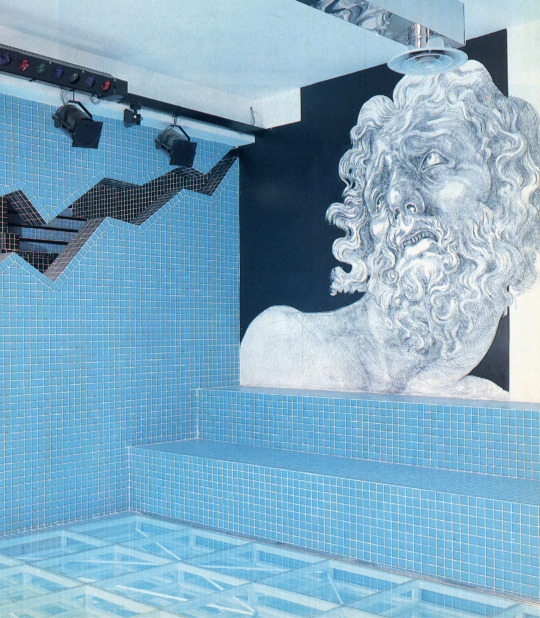



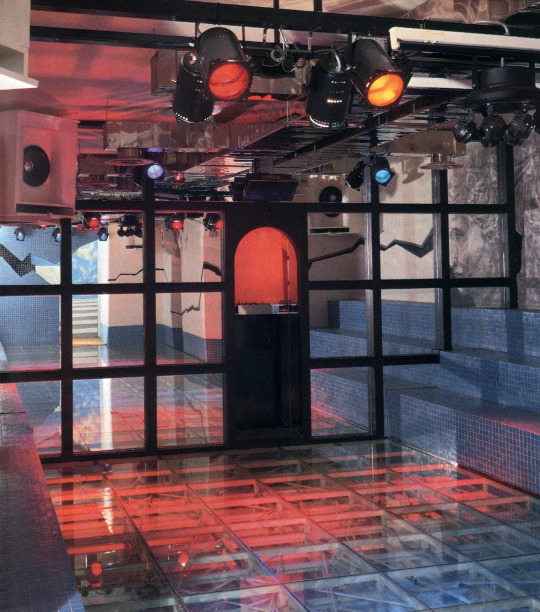


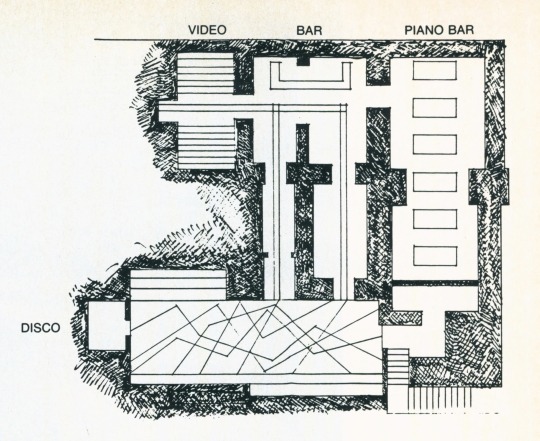
Subterranean Discotheque ‘Olimpo’ - Rome, IT (1987)
Designed by Pino Piantanida
“Mt. Olympus, so legend tells us, was the lofty habitat of the Greek gods, from which the deities ruled over the earthlings. Olimpo, by contrast, is a subterranean complex situated deep in the heart of Rome: a combined discotheque and piano bar, and the current favorite among the nocturnal haunts of the jeuness dorée. As for the reality, the site on which Olimpo stands (or, more explicitly, was sunk into) near the Pantheon was, in the days of Imperial Rome, the site of a complex of Roman baths, a fact whose authenticity was proved during excavations in that area. The boundary walls of the disco area are actually those of the baths. So much for history.
Pino Piantanida, the architect who envisioned and designed Olimpo, found his inspiration in both the myths of antiquity and the historic facts that were revealed to him. Giving his imagination free rein, he has created a dream-like atmosphere: one in which the gods and goddesses appear amid the evanescent clouds of a sky that is sometimes blue, sometimes flame-colored—an effect he has achieved through lighting and mirrors. Should the ancient Romans return to their old haunt, they would doubtless find the whole picture confusing. The young Romans of today. however, take it all in stride, and evidently feel completely at home with it.
For starters, the existing interior divisions of the area (3,800 sq. ft.) were demolished, and all traces of its former incarnations were erased. The space was then divided into three main rooms and one small bar. all interconnected by a labyrinthine system of corridors designed to effect a transition from one room to another and back again, returning by a different route, all of which may mystify the first-time visitor, as the designer doubtless intended it should.
Piantanida likes to think of the descent from the sidewalk into the depths of the disco as a descent into the Roman baths, and so he has used deep turquoise as the basic color here. Distant skies are painted in tempera by Piantanida and Leonardo Tonioni, his assistant, in varying pinks deepening into flame. Thus the three basic elements, earth, fire and water, are portrayed.
The floor of the disco room is made of structural glass and is lighted from beneath with blue, pink and flame-colored tubes that give to the floor a sensation of movement. The upper reaches are lighted only with spots at rare intervals, preserving the mysterious atmosphere. The ceilings and walls, above the "water line," are pure white, except for a simulated black crack, and for the finely drawn greater-than-life-size heads and figures of mythological figures. In the first room the head of Laocoon floats in clouds above the dancers; on another wall Diana fixes a victim with her arrow. Above the bar, Bacchus (after Bronzino) hovers, and in yet another room, the horses of Castor and Pollux assume the same pose as that in which they are seen in the famous sculpture group in the Piazza Quirinale. Structural glass, illuminated from beneath, in the same color combination as that used in the dance floor, is also used for the center paths of the corridors leading from room to room, leaving the walls and ceilings in near-darkness. The piano bar is simply furnished with comfortable chairs, sofas and small tables, and is dimly lit, except for the farthest wall, which has a trompe l'oeil mural of a fiery sunset. Piantanida has achieved his dramatic effects with contrasting lights and darks, and with brilliant hues against black and white. His original injection of mythological figures, finely drawn and of heroic proportions, adds wit to the whole harmonious scheme.”
See Neoclassical PoMo, Pomo Faux Ruins, and Pacific Punk Wave
Scanned from an April 1987 issue of Interior Design Magazine
296 notes
·
View notes
Video
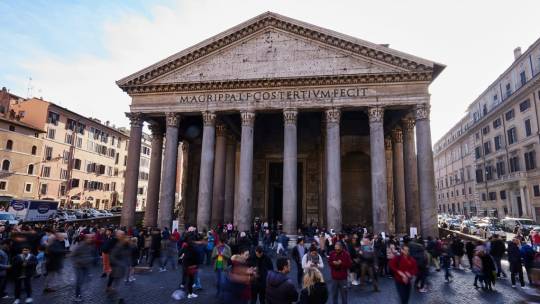
The Pantheon: The Ancient Building Still Being Used After 2,000-Years
When visitors walk into the Pantheon in Rome and encounter its colossal dome, they may experience the same theatricality as its guests nearly 2,000 years ago.
"Anyone who steps inside the Pantheon immediately feels the crushing weight of human history, but also the incredible lightness of human creativity," said John Ochsendorf, professor of architecture at MIT and former director of the American Academy in Rome.

"You come into this grand space and you look up and you see the sky or a passing cloud. And you think: 'How could they have done this nearly two millennia ago?'"
The Pantheon is the oldest building in the world that's still in use today. Since the 7th century, it has been a Roman Catholic church.
Built around 125 A.D. by the Roman emperor Publius Aelius Hadrianus, it was actually the third iteration of the structure. The first Pantheon caught fire around 80 A.D. and was rebuilt shortly after, but it was struck by lightning and burned down again around 110 A.D. The buildings' ill fate led to rumors that the Pantheon was cursed.
The facade of the completed structure riffed on ancient Greek motifs, with a portico entrance featuring a pediment -- a triangular top -- and two rows of Corinthian columns. The interior was sweeping and airy, capped by a dome that to this day -- is still the largest unsupported concrete dome in the world.
What was it used for?
Pantheon means "all gods," and though it's commonly thought the structure was a site of worship dedicated to Roman deities, its original purpose is actually unknown.
With scant mentions of it in Ancient texts, historians have been left somewhat in the dark. Though it could be a temple, Roman buildings were typically multi-purpose structures, said Lynne Lancaster, an architectural historian and humanities educator. "And so what actually went on in the Pantheon is hard to say."

Legends say it's the very site where Rome's founder, Romulus, ascended to heaven. Others believe the Pantheon was where the Roman emperor could communicate with the gods. Whatever the case, like many Roman architectural feats, the imposing structure was a show of might, an "important symbol of imperial power," said Luca Mercuri, the Pantheon's current director.
Indeed, Roman architecture of the time embodied wealth, strength and dignity. Centuries later, Neoclassical architects would reference the Pantheon's portico and dome combination to imbue their buildings with those same values, from the US Capitol in Washington, DC., to the Somerset House in London.
How was it built?
The Pantheon was an architectural marvel of the Roman Empire.
The oculus -- Latin for "eye" -- stretches 30 feet across, opening the structure to the heavens. The sun beams through the oculus, and when it storms, the rain comes down like a waterfall into the interior.

Legends say it's the very site where Rome's founder, Romulus, ascended to heaven. Others believe the Pantheon was where the Roman emperor could communicate with the gods. Whatever the case, like many Roman architectural feats, the imposing structure was a show of might, an "important symbol of imperial power," said Luca Mercuri, the Pantheon's current director.
Indeed, Roman architecture of the time embodied wealth, strength and dignity. Centuries later, Neoclassical architects would reference the Pantheon's portico and dome combination to imbue their buildings with those same values, from the US Capitol in Washington, DC., to the Somerset House in London.
How was it built?
The Pantheon was an architectural marvel of the Roman Empire.
The oculus -- Latin for "eye" -- stretches 30 feet across, opening the structure to the heavens. The sun beams through the oculus, and when it storms, the rain comes down like a waterfall into the interior.
"The oculus at the center seemed to tempt fate and leave (the Pantheon) open to the sky," said Ochsendorf. "But it also showed a mastery of geometry and construction -- that they could build domes on that scale and leave an oculus open at the center, in a way (that was) almost showing off."

One trick to make a large dome stable was to use progressively lighter stone in the concrete mix as it reached the top. Heavy brick could be used at the base, with spongy, light volcanic rock around the oculus.
Though the Pantheon has revealed some of its design secrets, Lancaster said she still finds magic in the details. As the day progresses, the sun flickers around the dome's interior, casting light over its sunken grid like a giant sundial.
"It's one of the few places in the world (where) you can actually watch the Earth turn."
By Jacqui Palumbo.
#The Pantheon#The Pantheon: The Ancient Building Still Being Used After 2000-Years#roman catholic church#roman emperor hadrian#architecture#building#ancient building#ancient artifacts#archeology#archeolgst#history#history news#ancient history#ancient culture#ancient civilizations#ancient rome#roman history#roman empire#roman architecture#roman archaeology#roman building#the might of rome#long reads
123 notes
·
View notes
Text

tiny tiny people...😏
The Interior of the Pantheon, Rome - Giovanni Paolo Pannini
7 notes
·
View notes
Text
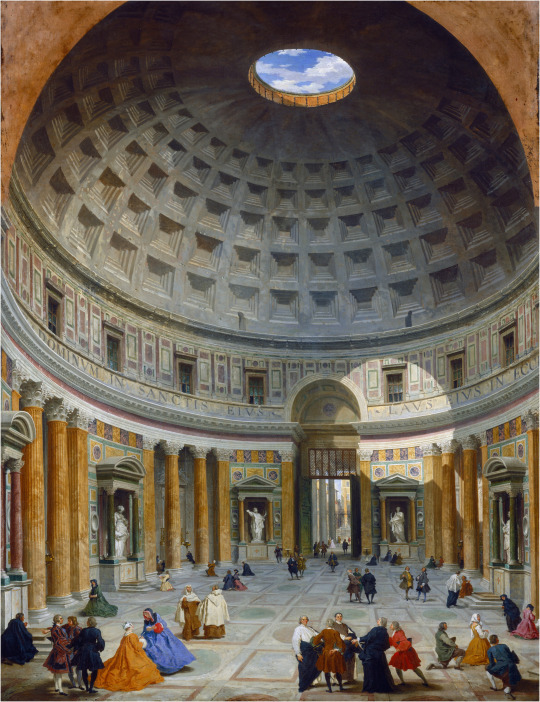
Giovanni Paolo Panini, Interior of the Pantheon, Rome, 1734, oil/canvas (National Gallery of Art, Washington D.C.)
48 notes
·
View notes
Text

So I couldn’t help but notice the exterior of the “Temple” in Faraway Paladin looks like St Marks Basilica in Venice Italy.

Although St Marks has five domes total, and the floor plan is of a Greek cross pattern. It was modeled after Byzantine architecture after all, which is why the interior looks kinda similar to the Hagia Sophia.



The temple in the anime though, from what I saw it looks like someone stuck a domed tower inside a cloister. The interior of the dome kinda mimics the Pantheon in Rome, but that’s where the similarity ends.
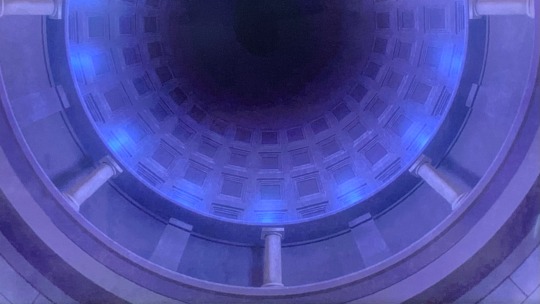

12 notes
·
View notes
Text

Interior of the Pantheon of Rome (1734)
Artist: Giovanni Paolo Pannini
2 notes
·
View notes
Text
Countries that are no more: Ancient Carthage (814BC-146BC)
The state discussed in this post is one of the most famous and important in antiquity. Yet, it remains one of the most elusive and mysterious civilizations in world history because its own written records have been virtually erased with all contemporary written records coming from foreign sources that both praised and reviled its existence. However, it was influential for its model of government, its expansion of Mediterranean trade, its influence on models of economic production, naval exploration and for its military leaders whose tactical and strategic prowess influence warfare to the modern day and for its rivalry with the other emerging Mediterranean superpower of antiquity: Rome. A rivalry that is characterized as the quintessential clash of civilizations. This is Carthage.
Name: In its native language, the Phoenician dialect known in Latin as Punic, it was 𐤒𐤓𐤕𐤟𐤇𐤃𐤔𐤕, or annunciated as qrt-ḥdšt or Qart-Hardasht. This translates into English as "New City". In Latin it was known as Carthago or Karthago, the modern English pronunciation of Carthage comes by way of French.
Language: Carthage as a city-state and its empire more broadly held a cosmopolitan mixture of peoples and languages. However, the founders of Carthage and its ruling elite spoke Punic, a dialect of Phoenician associated with the city of Carthage which was founded by Phoenician colonists from the Levant. Punic was Phoenician in origin and became a distinct local dialect of Phoenician speakers in Carthage and other cities. These settlers founded colonies throughout North Africa and the Western Mediterranean. The Phoenician language and its dialects were from the Semitic language family native to the Middle East. It originated as a distinct dialect of the Canaanite peoples from who the Phoenicians and subsequently the Carthaginians descend from. The Canaanites also gave rise to the other Semitic speaking peoples such as the Israelites, Moabites and Ammonites among others. Modern Hebrew is said to be the extant language most similar to ancient Punic. In Carthage's empire there were also local varieties of Berber (Amazigh) languages spoken by the native Berbers who settled in North Africa. There were also local languages in Iberia (Spain and Portugal) from the Iberian and Celtic tribes settled there and the languages of native Sardinian and Balearic peoples as well. Additionally, ancient Greek was spoken by Greek colonists, mercenaries and traders who also settled within Carthage's empire and sphere of influence.
Territory: The city of Carthage is located in the environs of modern Tunis, capital of the modern state of Tunisia in North Africa. It was from this centrally located city founded by Phoenician colonists that their subsequent empire grew. The established contact and control with other Phoenician colonies in the area such as nearby Utica and eventually grew to control all of coastal North Africa from modern Morocco to western Libya. The modern states of Morocco, Algeria, Tunisia and Libya were its core territory, with Tunisia being its heartland. It also included Malta, the western half of Sicily, Sardinia and Corsica's coastal regions, the Balearic Islands of Spain and the southeastern portions of Iberia, particularly the coastal areas with influence into parts of the interior and south of the Ebro River.
Symbols & Mottos: The symbols associated with the state of Carthage are often in reference to their pantheon of gods which were quite extensive but centered mostly around the Phoenician gods but also included Berber, Iberian and Greek influences within their pantheon as well. A military standard associated with Carthage includes a staff with a sun disc and topped with a crescent moon. Also, the sign of Tanit, a Phoenician goddess's whose symbol was found on Carthaginian ruins along with Phoenician ruins found back in the Phoenician colonists' homeland in the Levant (Lebanon, Israel and Syria). The sign of Tanit appears in many varieties but is usually found as a schematic like sketch of a person with a triangular base with a disc on top with horizontal lines then pointing upwards like raised arms.
Religion: With Phoenician settlers being the originators of Carthage its ruling elite, the primary state religion was their variety of the ancient Phoenician religion which was polytheistic and included many notable gods and goddesses from Tanit to Baal Hammon, Melqart and Astarte among others. Many of these gods found companions with the Greeks and indeed due to the interfacing with Greeks both through trade and war, some Greek gods would also be incorporated into the Carthaginian pantheon, though it remained distinctly Punic at its core. There also appears to be Berber (Libyan and Numidian) influences along with Sardinian and Iberian interfacing that both saw the spread of worship of the Punic/Phoenician deities with local influences likewise being adopted by the Carthaginians. Even some ancient Egyptian gods appear to be included in Carthaginian worship. This syncretism and tolerance reflect the cosmopolitan outlook and composition the Carthaginians had within their realm.
There were priests who maintained the temples and sanctuaries devoted to particular deities. Likewise, Carthaginians practiced everything from ritual banquets to funerary rites such as those in the Levant like disposing of the remains of the dead, feasts for the dead, ancestor worship and goods in the tombs of the dead, indicating belief in life after death. Cemeteries were often built outside the walls of Punic settlements and included stelae with inscriptions serving as grave markers. Carthaginians practiced both burial and cremation.
There does appear to be cases of animal sacrifice to appease the gods in Carthaginian society as well. This tended to follow very specific regulations and rules.
The most controversial topic of the Punic religion however appears to be the practice of child sacrifice. The sources for this we must bear in mind come from Greco-Roman writers that weren't known to actually witness the practice and from civilizations that had biases toward Carthage more broadly. Yet both Greek and Roman sources cite the Carthaginians as practicing child sacrifice in their religion. These sources sometimes do contradict one another in their specifics. Modern historians debate the extent of this practice and what are the contents found at the sites known as Tophet in urns with ashes that may come from human infants. The Greco-Roman sources state children were specifically killed for ritual purposes and killed in various manners and burned as offerings. Based on archaeological findings some historians take the position that the practice may have occurred but may have been relegated to the ritual cremation of infants who died of natural causes. Others uphold the Greco-Roman sources and other deny the practice at all, chalking it up as pure invention of biased sources from Greece and Rome. Because Carthage was destroyed by Rome in 146 BC and virtually all extant written sources on Carthage come from Roman and Greek sources, there doesn't appear to be any definitive answer to this practice's purported extent or even its existence. Modern archaeology can lend more nuance to the topic but a clear answer like much of what we know about Carthage and its society remains a mystery.
Currency: The basic coinage of Carthage was called the shekel which derived from its Phoenician antecedents. There were gold, silver and bronze coins found throughout Carthage's empire. Mints were found not only in North Africa but Sicily and Iberia. Coins depicted everything from date palm trees to famous soldiers and politicians both Carthaginian in origin like the Barcid family of Hannibal Barca and even Greek rulers such as Alexander the Great.
Population: At its peak the empire had probably 3.7-4.3 million people. The city of Carthage proper at its peak was anywhere 250,000-500,000 people.
Government: The basis of our understanding of Carthage's governance is limited and largely based on ancient Greek and Roman sources. Some of which write of it in disparaging terms and others praise it for its complexity and nuance.
The basic understand is that during the first few centuries of Carthage's existence it was probably a monarchy. However, the extent to which the kings ruled over Carthage is debated. The Phoenician city states from which Carthage descended, namely Tyre had nominal monarchs but who deferred to a council of advisors who helped craft policy and administer the law. It seems reasonable that Carthage followed this political model in its earliest stages with nominal monarchs who likewise consulted a council of advisors made up Carthaginian nobility to craft and administer policy. The degree to which kings of Carthage held power probably fluctuated.
Following the First Sicilian War against the Greek colonists on Sicily in 480 BC, the nature of Carthage's government changed gradually with a weakening of the monarchy. By the 300s BC Carthage was at its peak and best characterized as an oligarchic republic. It was noted to have numerous checks and balances on the branches of government, a vast and complex administrative state, high levels of public accountability and participation in civic duty. Aristotle the famed Greek philosopher wrote on Carthage in his treatise "Politics" as the only non-Greek polity to be represented in the work.
Carthage as a republic became ruled nominally by two simultaneously elected non-hereditary magistrates called sufetes or shophets. This position's title translates as "judges" and they are said to handle a mix of judicial and executive powers. How they were elected and who was eligible for this head of state position is not known. What is known is they were always from the oligarchic ruling class of Carthage and that they held annual terms. The Roman writer Livy states this was comparable to the Roman republican practice of electing two consuls for annual terms. They are said to have ruled jointly and likewise handled matters of state through the convening and presiding over the supreme consultative council known as Adirim (similar to the Roman Senate), submitting legislation to the popular assembly and adjudicating trials. The sufetes interestingly did not hold any military power as this was separated and reserved for military commanders with the generals reporting to the Carthaginian assembly in the Adirim.
The Adirim held about 30 members on the council and like senators in Rome were elected from the wealthy elite merchant families of Carthage. They administered the treasury, conducted foreign affairs and providing some control over military affairs. It is said matters of state required unanimous decision making to go into effect.
Carthage also had judicial assembly called the One-Hundred and Four. These judges provided oversight of the military and other politicians and bureaucrats within Carthage. As an example of Carthage's political checks and balances, the One-Hundred and Four had the power administer monetary fines or even the death penalty, sometimes by crucifixion on military or government officials found to have engaged in unbecoming behavior that went against the interest of the public. It also formed small committees to provide oversight on political matters.
Separate from these bodies also came numerous junior bureaucratic positions to held administer everything from tax collection, public works and the state treasury.
Carthage also contained at local levels trade unions, a popular assembly and town meetings. In matters where the sufetes and Adirim could not decide law in a unanimous manner a popular assembly was consulted to make a final determination. Whether this was a formal institution or ad hoc solution has never been determined.
Aristotle singled out the Carthaginian government as more meritocratic than its contemporary Greek counterparts. He also praised its complex balance of monarchical, aristocratic and democratic elements. Some other Greek writers went so far as to say it was the best form of government in existence at that time only equaled in the Greek world by Sparta. Meanwhile, Aristotle himself stated that Carthage had some form of constitution and found it superior to Sparta's.
The Greek historian Polybius writing for a Greco-Roman audience in his commentary on the Punic Wars between Rome and Carthage stated that Carthage had more democratic elements than Rome did and that the common people were on average given more say than Romans at the time. However, Polybius saw this as a detriment to Carthage during the Punic Wars, in his estimate too much bickering and infighting to gain a unanimous decision led to paralysis and indecision. Whereas he favored the Roman Senate's rules which were less democratic overall and therefore more decisive in determining important decisions at crucial moments such as in war.
Carthage's republican government appears to have been replicated in the colonies and territories throughout its empire with sufetes found at local colonial levels. There appears to be cooperation between Punic colonial officials and the local population under Carthaginian rule.
Carthage was primarily mercantile in its outlook. The control of trade commodities and goods throughout the Mediterranean was the basis for its economic development and always of primary concern. Hence the merchant class-oligarchy's vested interest in maintaining power.
Military: Carthage was a classic example of a maritime power. Its navy was its most important military branch in many ways. The navy was used to ensure control over the network of trade routes between the various parts of the Western and Central Mediterranean. It would win naval victories over its Greek and Roman rivals though it would ultimately face defeat by the Romans.
The navy was large in size for antiquity and benefitted from the Phoenician advent of serial production, the ancient equivalent of assembly line production which produced ships of good quality but in an efficient manner. They could maintain hundreds of ships at one time, even after their power dimmed with the rise of Rome.
The ethnic composition of the navy's sailors, oarsman, navigators and marine force was almost exclusively Phoenician. Given the Phoenicians long association with seafaring trade and navigation, the Carthaginians merely upheld this tradition including in warfare.
The army of Carthage, its land based military branch was also crucial in achieving its geopolitical goals. From the subjugation of rebellious tribes in North Africa and Iberia to battling the Greeks and Romans in foreign wars. In conjunction with the navy the ultimate goal was maintaining Carthage's control of trade routes and upholding its sphere of influence to maintain favorable conditions for said trade.
Due to the limited population of Phoenician colonists spread throughout the Carthaginian empire and given their traditional naval prowess, much of the army was not of ethnic Phoenician/Punic background. Instead, they relied on a multinational mix of auxiliaries and mercenaries to fill the armies ranks. There might be Phoenician officers and generals such as the famed Hannibal Barca and his relatives including his father Hamilcar and brothers Mago and Hasdrubal, but many other officers could be Greeks among others. The rank and file including Greek mercenaries fighting in the hoplite style, many Greek colonists from Sicily and Southern Italy, Berber infantry and cavalry, particular the light cavalry of Numidia famed for its fast-moving skirmishers armed with javelins and the Libyan infantry. Iberian infantry and cavalry of mixed Celtic and Iberian backgrounds. The famed light skirmisher infantry from the Balearic Islands who slung stones at their enemies were likewise part of the army. Also included in the army were Gallic (Celtic) infantry and cavalry from France and Italy, Sardinians (Nuragic) and Italic peoples such as Samnites, Lucanians, Etruscans and even some Latin peoples including Roman defectors could be found among Carthage's land army. The Phoenician rank and file in the army were usually colonists from other Punic settlements and not Carthage proper. The exception being the famed 3,000 strong Sacred Band of Carthage which were derived from the strongest and healthiest of Carthage's wealthiest families to fight as an elite special unit of the army. Armed and trained int the Greek hoplite style and phalanx formation.
The army also utilized African Forest elephants as a mobile force similar to a wrecking ball. These elephants provided a fearsome complement to the army and was famously used by Hannibal Barca in his crossing of the Alps to invade Roman Italy during the Second Punic War.
The major conflicts Carthage fought in its history were its colonial wars in North Africa against Berber tribes and kingdoms, Iberia and in Sicily first against the Greeks and later against its archrival Rome. The three Punic Wars fought between Carthage and Rome have been characterized by some historians as the ultimate and perhaps most important clash of civilizations in the ancient world and perhaps of all time. Ultimately, they would all end in Rome's favor and eventual destruction and razing of Carthage by Rome, ending Rome's biggest rival and leading to Roman supremacy over the Mediterranean basin for the next several centuries.
Economy: Economic concerns were of chief importance to the Carthaginians. Their empire was essentially a commercial one or rather an expansive and complex trade network with the state trying to aggressively uphold and expand its scope. Its origins lie with the Carthage's Phoenician roots. The Phoenicians based in the Levantine coast (mainly modern Lebanon, Israel and Syria) weren't one united people but rather a series of city states, with the most powerful being based on the coast. These included the cities of Byblos, Sidon and Tyre among the leading polities and all with an outward maritime trade orientation. The Phoenicians produced many goods and economic models that would be both enriching and influential on trade throughout the ancient world. This included purple dye for fabric, uncolored glass, wine production and Lebanese cedar for timber production and the serial production economic model.
Carthage was founded in modern Tunisia by Phoenician colonists from the city of Tyre (Lebanon) in the 9th century BC. They were not the first Phoenician colony in North Africa but they eventually rose to become the most aggressive and successful. In part this was due to its secure and strategic location. It soon became the leading trade center on the Western and Central Mediterranean. They controlled trade routes at sea and rose to prominence and domination among all the other Phoenician colonies setup in North Africa, Sicily, Malta, Sardinia and Iberia.
Mining for metals silver, lead, copper and tin were of crucial importance for the wealth of Carthage, in particular this motivated their expansion into Iberia. Additionally, the temperate and fertile climate of the Western Mediterranean lead to much wine production. They also traded in amber, timber, grains an food preservatives.
While mostly a maritime trade power, Carthage also had overland caravans to secure goods from the African interior and even the Middle East. Continual exploration for new and expanding trade routes and goods was also important for Carthage. Famed Carthaginian explorers of Punic origin included Himilco the Explorer who lived in the 6th and 5th centuries BC. He is said to have been the first Mediterranean sailor to have explored the Atlantic routes to Northwest Europe, visiting Portugal, France and the British Isles. Britain in particular was important to the ancient tin trade which was necessary in bronze production. Britain was known in the ancient world to the Carthaginians and Greeks as the Tin Isles.
Hanno the Navigator was said to have explore trade routes to western Africa. Reaching as far as modern Senegal and Cameroon,
Lifespan: Carthage was said to have been founded by Phoenician colonists from the city of Tyre circa the 9th century BC. A foundation legend raised from its founding. Namely the legend of Princess Dido from Tyre leading her fellow Phoenicians not as colonists looking for commercial benefits but political refuge from her dictator brother. According to legend Dido and her retinue arrived at Tunisia and tricked the local Berber king into grating them a sizable tract of land from which the core of what became the city of Carthage was founded.
The city was given the name by its settlers of Qart-Hadasht, which in the Phoenician language meant "New City". The year 814 BC is often cited as the approximate date of its founding.
Quickly Carthage made an association with and eventual domination of fellow Phoenician colonies in the area including Utica. Its favorable climate, arable land and strategic location were all crucial to Carthage's rapid growth and dominance of over other Phoenician colonies. It would expand to conquer lands ranging from the whole of North Africa from Morocco to Libya, the islands of Malta, Sicily, Sardinia, Corsica and the Balearics and parts of the Iberian Peninsula over the coming centuries found themselves either under direct Carthaginian rule or favorable treaties incorporating the lands into its sphere of influence hence creating a trade network and empire, a classic example of a thalassocracy.
Initially, the Carthaginians paid a tribute and maintained contact to its mother city of Tyre back in Lebanon. However, this became an irregular occurrence due to Carthage's increasing independence due to its great distance from the Levant and the assertive character to its own local citizenry. Carthage began to see a mix of Phoenicians and local Berbers creating a unique Punic culture that synthesized the two cultures and ethnicities over time with the Phoenician dialect and culture remaining dominant but adaptable for its ability to incorporate other cultures. This was true as its sphere of influences expanded in the Mediterranean.
Carthage's independence was not only due to its relative distance from Tyre but due to the events back in Phoenicia. Various sieges from Babylonia and eventually later the Persian Achaemenid Empire conquered Phoenicia including Tyre circa 530-522BC. The subjugation of these lands reduced contact between the Carthaginian settlers and their Tyrian origins which had until that date sent a steady flow of colonists. While some flow of other Phoenicians would continue, the population would be buttressed by local native populaces and other Phoenician colonies rather than direct Tyrian migration.
The city of Carthage itself expanded over the centuries and created several distinct districts and architecture. At its peak in the 4th century BC, it contained a population between a quarter and half a million people. making it one of the world's largest and most prosperous cities at the time. The city had a mix of wealthy villas, apartment blocks six stories high, had warehouse and commercial districts, goods markets, a Greek style agora or public space, elaborate gardens. temples to various gods, various government buildings and a unique double harbor known as the cothon, which became the physical feature along with the Byrsa hill most associated with Carthage. The cothon featured an outer commercial harbor and military inner harbor with ship warehouses on a man-made island from which ship repairs, construction and maintenance could be addressed through its serial production. The Byrsa hill was the central district of Carthage which contained important temples, it had stair way avenues which were relatively wide for traffic, whereas most of the city's routes had narrow winding paths to navigate. The city was said to have triple walls for defenses, a shorter outer wall made of either stone or wood, followed by a ditch, a second taller stone wall 5 meters thick, a second ditch and a third stone wall 10 meters thick and with armed towers able to hold a force of over 20,000 troops.
In 509 BC it signed its first treaty with Rome, its eventual rival which at the time was the inferior power still clamoring for power on the Italian peninsula. The treaty was meant to demarcate their respective spheres of influence. From 580-265 BC, the Carthaginians found themselves in a series of wars with the Greek colonies of Sicily and Southern Italy. Namely, the city state of Syracuse which was the principal Greek settlement on Sicily.
These wars were back and forth in nature, marked by victory and defeat on land and sea for both sides. Eventually Carthage would retain control over the western half of Sicily until its loss of control in the Punic Wars with Rome. The Sicilian Wars also saw the gradual weakening of the kings of Carthage and its transition to an oligarchic republic (see government section).
The Punic Wars (264-146 BC) began almost by accident with neither Rome nor Carthage initially planning a direct confrontation with the other. The city of Messana (Messina) in Sicily found itself in the 260s BC under the control of a group of Italian mercenaries who had previously served the tyrant (king) of Syracuse who had died in 280 BC. These independent mercenaries were a threat to both Carthage and Syracuse's interests on Sicily. These mercenaries named the Mamertimes (Sons of Mars) divided into two factions, over the issue of the new Syracuse tyrant Hiero II's planned retaking of Messana. One faction advocating a Carthaginian intervention to take charge of the city's security and the other advocating for Roman intervention from the Italian peninsula. Carthage arrived first with a land garrison and naval fleet in the harbor. The Roman Senate was reluctant to assist the mercenaries but recognized the potential threat a permanent presence of Carthaginians in Messana and its location on the narrow Straits of Messina between Sicily and Italian mainland could pose on Roman trade and security. It advocated sending an expeditionary force to retake Messana to eject the Carthaginians. The attack triggered the first Punic War between the two powers. It turned into a quarter century struggle that was marked by intense fighting mostly on Sicily.
The First Punic War was ultimately a Roman victory that ended Carthage's presence on Sicily. It also saw Roman advances in naval technology such as the corvus to help board Carthaginian ships. Hitherto the Romans had little naval strength relative to Carthage but its innovations in naval warfare proved crucial in undermining Carthage's longstanding naval superiority. Meanwhile on land, despite the back-and-forth nature of the battles, the Roman army's tactical flexibility often proved superior to Carthage which after 23 exhausting years agreed to peace. It gave up control of Sicily to Rome (aside from Syracuse) and paid a tribute over the course of 10 years.
Rome also after the war used Carthage's distraction against a Libyan rebellion in the Truceless War to take control of Sardinia and Corsica in 238 BC.
To compensate for the loss of territory on Sicily, Sardinia and Corsica, the Carthaginians under Hamilcar Barca tried to expand its territory in Iberia against Celtic and Iberian tribes especially to profit from increased mining production. They also gained new manpower and agricultural production to boost their economy and military again. They also had a standing agreement with Rome to not intrude north or south of the Ebro River respectively. However, an Iberian city of Saguntum south of the Ebro had an agreement with the Romans. This upset the balance of power established with Carthage in Iberia. Hamilcar Barca's son Hannibal now in charge of the Carthaginian army in Iberia an avowed enemy of Rome, besieged Saguntum which he took in 8 months. This is turn led to Rome's declaration of war, starting the Second Punic War which lasted for the next 17 years.
In one of the most famous military campaigns of all time, Hannibal and his army complemented by Carthaginians, Numidians, Celts, Iberians crossed the Alps and invaded Italy, taking the war to Rome's home territory. Hannibal showing his tactical prowess would defeat Roman armies repeatedly on their own territory most notably at the Battle of Cannae in 216 BC. Many Italian cities that had been incorporated into Roman rule over the previous centuries rose up to join Hannibal against Rome. However, Hannibal never had sufficient strength to directly besiege Rome. Rome was constantly tested by Hannibal's victories over the next 13 years in Italy, but they refused to surrender and adopted an attritional strategy, and this wore down Hannibal by gradually retaking Italian cities allied to him if not able to defeat him directly. Likewise, they repelled Carthage's attempts to reinforce him in Italy. They also faced mixed success gradually conquering Iberia from the Carthaginians. Finally, an invasion of Tunisia forced Carthage to recall Hannibal back to North Africa to defend the capital from a Roman assault. He met the Romans in the Battle of Zama in 202 BC which resulted in a Roman victory over Hannibal himself at once.
Hannibal advocated for the government of Carthage to negotiate a treaty with Rome which it did. Its terms were harsh. A stripping of all overseas possessions of Carthage in Iberia and elsewhere including some African territories. A large punitive indemnity to paid to Rome over 50 years. A reduction of Carthage's navy ten warships, a ban on Carthage's use of war elephants. A prohibition on Carthage being able to fight war outside of Africa and any war it wages in Africa must require Rome's express permission.
Hannibal eventually became a sufete in Carthage and worked to reform the government of Carthage and stamp out corruption so as to ensure its ability to pay Rome its due from the treaty and rebuild its economy. Indeed, Hannibal was somewhat successful in his regards and Carthage's economy was somewhat rebounding but facing pressure from Rome and enemies in the local government, he went into voluntary exile in service to Greek states opposed to Roman expansion in the east. He died in exile under murky circumstances variously described as a suicide or murder.
The Third Punic War 149-146BC began will Carthage went to war in Africa with Berbers who were raiding its territory and without Rome's permission, this was used a pretext to attack Carthage itself by Rome for violating its treaty from the previous war. The third and final Punic War was characterized by a three-year siege of Carthage. Ultimately, the Romans after much pressure on both sides broke through its triple walls and assaulted Carthage in street-by-street fighting. The city was razed to the ground, much of its population killed by angered Roman troops. 50,000 Carthaginians were enslaved and sent elsewhere through the Roman Republic's empire. Carthage was no more as an independent political entity after 146 BC. A century later, Rome rebuilt the city on its ruins as part of its empire and it remained an important city within the Roman Empire until the fall of the Western half of the empire where it fell to the Germanic barbarians the Vandals who had their capital in Carthage, it was reclaimed by the Easter Roman Empire (Byzantine Empire) by the forces of Belisarius in service to Justinian I. Carthage would face a final destruction as a Roman city when the Arabs of the Umayyad Caliphate destroyed the city in the year 698 AD. It never rose as a city again, instead its ruins remain part of the suburbs or the modern city of Tunis, capital of Tunisia.
Carthage despite its being steeped in legend and mystery remains worthy of study as one of the undeniably great civilizations of antiquity. A fact recognized by its contemporaries whether they wrote of it a complimentary fashion or with contempt, its power, wealth and influence was immense enough to engender scholarly study and reflection at the time. It is for these contemporary recognitions whether positive or negative and absence of surviving self-records that many continue its study into the modern age. Particularly its opposition to Rome and the perception by Rome that it was a worthy rival that needed complete annihilation, especially given Carthage's ability to stand up to Rome in a way no other power really could at its peak.
The more Carthage is analyzed both by its contemporary foreign commentators with the surviving archaeological and fragmentary historical record, the more nuance can be shed on the complexity of the civilization and influence it had on world history. Its opposition to Rome might be its most noted aspect but it shouldn't overshadow how else Carthage influenced the world. From its complex style of government and network of commercial imperialism that presaged future thalassocracies such as the Italian republics of the Middle Ages like Venice and Genoa and how it produced economic production models which influenced Rome and Greece and subsequently other areas of the world, they carried that influence on to. Likewise, another legacy of Carthage was how it helped build an ancient iteration of a globalized economy, shrinking the gap between the long distances of the ancient Mediterranean world by linking disparate geographies and peoples under a common commercial interest. In this commercial pursuit it also revealed itself to have both a distinct dominant culture but one that was not intolerant or unable to accommodate and absorb other cultural influences. In many ways ancient Carthage by way of its influence on Greece and Rome and their own influences give us glimpses into how its existence served as a precursor to the modern world we inhabit.



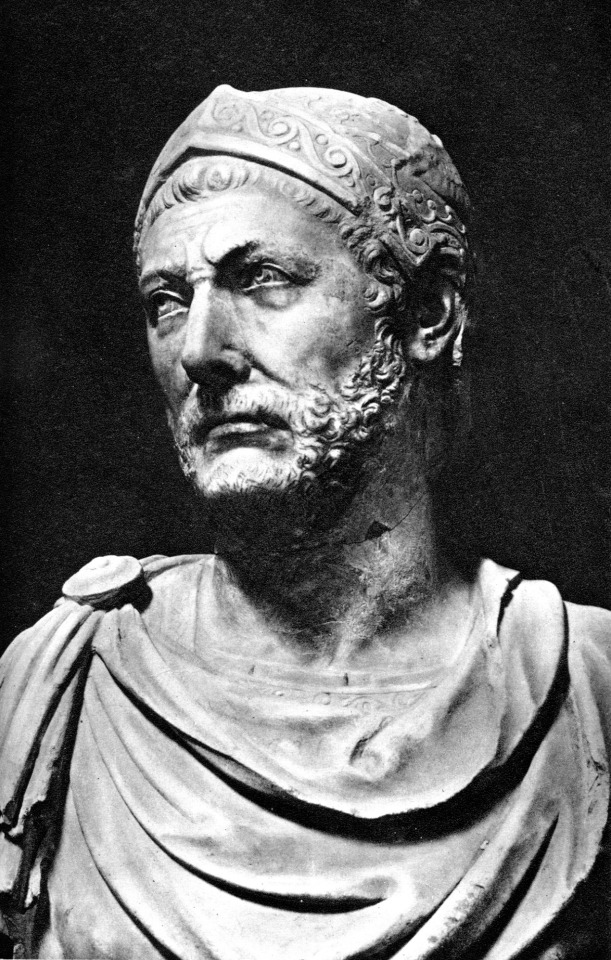


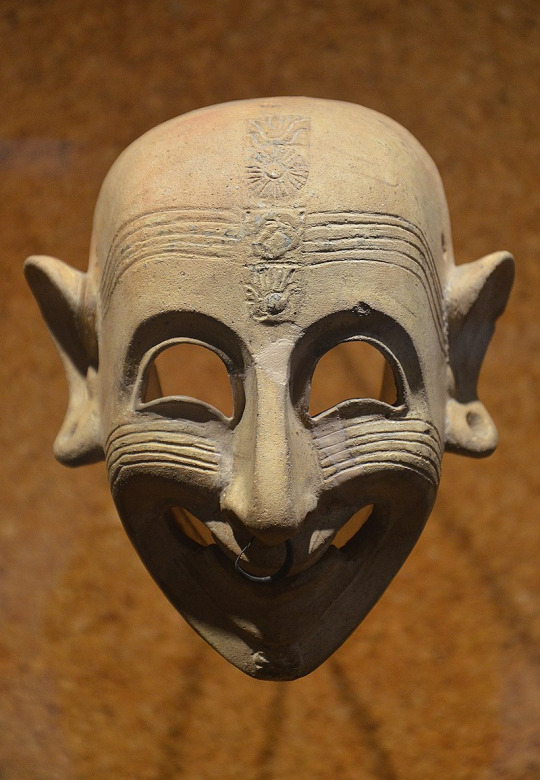



#history#military history#ancient history#ancient world#ancient ruins#ancient carthage#carthage#ancient rome#ancient greece#tunisia#iberia#hannibal#scipio africanus#ancient phoenicia#phoenician#punic wars#sardinia#sicily#corsica#malta#balearic
4 notes
·
View notes
Text

Interior of the Pantheon, Rome by Giovanni Paolo Panini (1734)
30 notes
·
View notes
Text
Cheap flight to Rome, Italy
Quartiere Coppedè
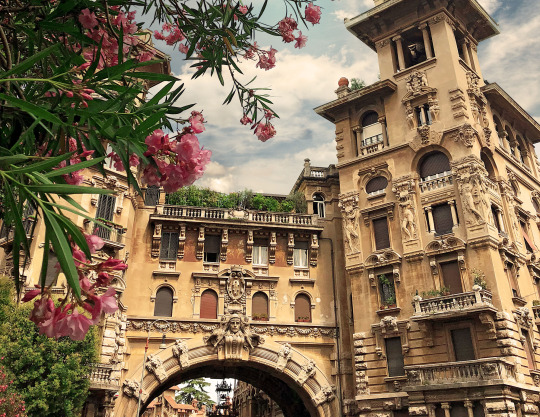
The Coppedè neighborhood of Rome is like entering a fairy tale squeezed between four streets, on the corner of Via Dora and Via Tagliamento. There are a couple of very nice buildings and a square with a fountain, which although they will not taste like much will make the visit totally worthwhile.
One advantage of this area is that not being so well known it is a refuge from the tourists that crowd the streets of Rome, where to rest and take some very nice pictures in the light of the sunset. This, among other things, is one of the things I recommend you do on your visit to Rome.
Basilica di Santo Stefano Rotondo al Celio
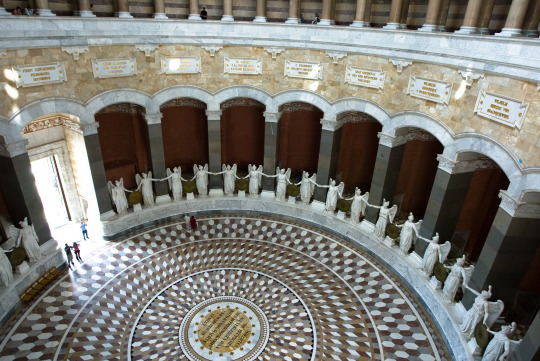
I could choose any of the thousand or so churches in Rome to recommend, after all, you will most likely visit between ten and twenty on your trip, but the Basilica di Santo Stefano Rotondo al Celio is one place I can't resist mentioning you.
Honestly, there is no match for St. Peter's Basilica. But this isn't about finding a basilica to rival the Holy See's: it's about finding the place that other eyes won't mistakenly deem worth perching on.
Because of its proximity to the Colosseum, the Basilica di Santo Stefano Rotondo al Celio is the one that perfectly fulfills what we're looking for. Its circular architecture, its somber interior decorated with frescoes of martyrdoms, and its sepulchral atmosphere create an atmosphere that you will find in few places in Rome.
Palazzo Doria Pamphilij

This palace is one of the most overlooked places in Rome. It is in the center of the city, near the Trevi Fountain, the Pantheon and the monument to Victor Emmanuel II, and on the outside it is beautiful, but inside it is a baroque fantasy and contains a museum that you can visit, the Doria Pamphilij Gallery.
The museum collection belongs to the family that gives its name to the palace, with works of art by Raphael, Titian and Velazquez among other painters, exhibited in a gallery decorated with opulence and luxury.
A place to take a break from the hustle and bustle of the Roman streets, especially inside the museum where you will find a colonnaded courtyard where the sun shines in a special way.
Find out the cheapest way to get to Rome and see those sights here:
youtube
#transportation#travel stories#cheap travel#travel tips#traveling#travel#flights#flight tickets#cheap flights#flight booking#flight ticket booking#rome italy#rome#Youtube
5 notes
·
View notes
Video
Tomb of Raphael by Henrik Sundholm
Via Flickr:
This is the tomb of famous Renaissance artist Raphael. It's located in the Pantheon in Rome, Italy.
#coffin#chest#crypt#arch#architecture#building#marble#light#shadows#history#historical#pantheon#rome#roma#interior#italy#italia#artist#painter#raphael#tomb#grave#hdr#flickr
0 notes
Photo

interior of the pantheon, rome (1747), giovanni paolo panini
10 notes
·
View notes
Text
Temple Research Pt2
The Pantheon:
The Pantheon is a famous ancient Roman temple located in Rome, Italy. Built nearly 2,000 years ago during the reign of Emperor Hadrian, it is renowned for its remarkable architecture and engineering. The Pantheon's most distinctive feature is its massive domed roof, which was the largest of its kind for centuries. The building served as a temple dedicated to all the gods of ancient Rome and later converted into a Christian church. Today, it stands as one of the best-preserved ancient Roman buildings and continues to be a popular tourist attraction, admired for its grandeur and historical significance.

I think The Pantheon is incredible, I especially think that the interior is beautiful. This is the type of temple I had in mind for my second world as I think I could incorporate magic into it quite easily and convincingly. Another reason as to why I might use the Pantheon is due to its popularity, this could make my life easier as there may be 3D assets readily available for my use. I will definitely be looking at this for my second world.
1 note
·
View note
